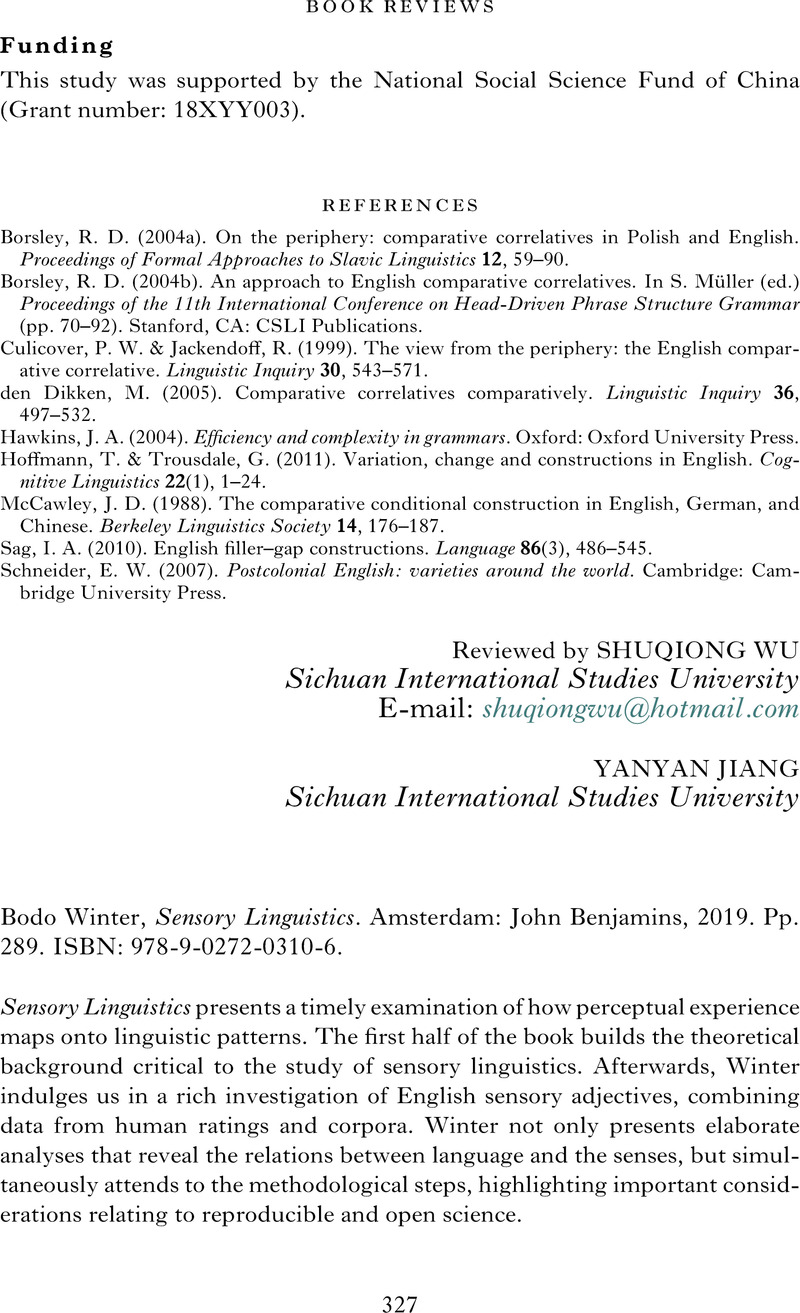No CrossRef data available.
Article contents
Bodo Winter, Sensory Linguistics. Amsterdam: John Benjamins, 2019. Pp. 289. ISBN: 978-9-0272-0310-6.
Review products
Bodo Winter, Sensory Linguistics. Amsterdam: John Benjamins, 2019. Pp. 289. ISBN: 978-9-0272-0310-6.
Published online by Cambridge University Press: 05 January 2021
Abstract
An abstract is not available for this content so a preview has been provided. Please use the Get access link above for information on how to access this content.

- Type
- Book Review
- Information
- Copyright
- © The Author(s), 2021. Published by Cambridge University Press on behalf of Language and Cognition
References
Barsalou, L. W. (1999). Perceptual symbol systems. Behavioral and Brain Sciences 22(4), 577–660.CrossRefGoogle ScholarPubMed
Barsalou, L. W. (2008). Grounded cognition. Annual Review of Psychology 59(1), 617–645.CrossRefGoogle ScholarPubMed
Chu, S. & Downes, J. J. (2002). Proust nose best: odors are better cues of autobiographical memory. Memory & Cognition 30(4), 511–518.CrossRefGoogle ScholarPubMed
Connell, L. & Lynott, D. (2014). I see/hear what you mean: semantic activation in visual word recognition depends on perceptual attention. Journal of Experimental Psychology: General 143(2), 527–533.CrossRefGoogle ScholarPubMed
Davies, M. (2008). The Corpus of Contemporary American English (COCA): 560 million words, 1990–present. Online <https://www.english-corpora.org/coca/>.Google Scholar
Gibbs, R. W. (1994). The poetics of mind: figurative thought, language, and understanding. Cambridge: Cambridge University Press.Google Scholar
Khan, R. M., Luk, C.-H., Flinker, A., Aggarwal, A., Lapid, H., Haddad, R. & Sobel, N. (2007). Predicting odor pleasantness from odorant structure: pleasantness as a reflection of the physical world. Journal of Neuroscience 27(37), 10015–10023.CrossRefGoogle ScholarPubMed
Lakoff, G. & Johnson, M. (1980). Metaphors we live by. Chicago, IL: University of Chicago Press.Google Scholar
Levinson, S. C. & Majid, A. (2014). Differential ineffability and the senses. Mind & Language 29(4), 407–427.CrossRefGoogle Scholar
Lynott, D. & Connell, L. (2009). Modality exclusivity norms for 423 object properties. Behavior Research Methods 41(2), 558–564.CrossRefGoogle ScholarPubMed
Lynott, D. & Connell, L. (2013). Modality exclusivity norms for 400 nouns: the relationship between perceptual experience and surface word form. Behavior Research Methods 45(2), 516–526.CrossRefGoogle ScholarPubMed
Olofsson, J. K. & Gottfried, J. A. (2015). The muted sense: neurocognitive limitations of olfactory language. Trends in Cognitive Sciences 19(6), 314–321.CrossRefGoogle ScholarPubMed
O’Meara, C., Speed, L. J., San Roque, L. & Majid, A. (2019). Perception metaphors: a view from diversity. In Speed, L. J., O’Meara, C., Roque, L. San & Majid, A. (eds), Perception metaphors (Vol. 19, pp. 1–16). Amsterdam: John Benjamins.CrossRefGoogle Scholar
Rolls, E. T. (2004). The functions of the orbitofrontal cortex. Brain and Cognition 55(1), 11–29.CrossRefGoogle ScholarPubMed
Ronga, I., Bazzanella, C., Rossi, F. & Iannetti, G. (2012). Linguistic synaesthesia, perceptual synaesthesia, and the interaction between multiple sensory modalities. Pragmatics and Cognition 20, 135–168.CrossRefGoogle Scholar
Royet, J.-P., Plailly, J., Delon-Martin, C., Kareken, D. A. & Segebarth, C. (2003). fMRI of emotional responses to odors: influence of hedonic valence and judgment, handedness, and gender. NeuroImage 20(2), 713–728.CrossRefGoogle ScholarPubMed
San Roque, L., Kendrick, K. H., Norcliffe, E. J., Brown, P., Defina, R., Dingemanse, M., … Majid, A. (2015). Vision verbs dominate in conversation across cultures, but the ranking of non-visual verbs varies. Cognitive Linguistics 26, 31–60.CrossRefGoogle Scholar
Shaoul, C. & Westbury, C. (2013). A reduced redundancy USENET corpus (2005–2011). University of Alberta 39(4), 850–863.Google Scholar
Shen, Y. & Cohen, M. (1998). How come silence is sweet but sweetness is not silent: a cognitive account of directionality in poetic synaesthesia. Language and Literature 7(2), 123–140.CrossRefGoogle Scholar
Speed, L. J. & Majid, A. (2020). Grounding language in the neglected senses of touch, taste, and smell. Cognitive Neuropsychology 37(5/6), 363–392.CrossRefGoogle ScholarPubMed
Strik Lievers, F. (2015). Synaesthesia: a corpus-based study of cross-modal directionality. Functions of Language 22(1), 69–95.CrossRefGoogle Scholar
Ullman, S. (1945). Romanticism and synaesthesia: a comparative study of sense transfer in Byron and Keats. Publications of the Modern Language Association of America 60, 811–827.CrossRefGoogle Scholar
Viberg, A. (1993). Crosslinguistic perspectives on lexical organization and lexical progression. In Hylenstam, K. & Viberg, A. (eds), Progression & regression in language: sociocultural, neuropsychological, & linguistic perspectives (pp. 340–385). Cambridge: Cambridge University Press.Google Scholar
Warriner, A. B., Kuperman, V. & Brysbaert, M. (2013). Norms of valence, arousal, and dominance for 13,915 English lemmas. Behavior Research Methods 45(4), 1191–1207.CrossRefGoogle ScholarPubMed
Willander, J. & Larsson, M. (2006). Smell your way back to childhood: autobiographical odor memory. Psychonomic Bulletin & Review 13(2), 240–244.CrossRefGoogle ScholarPubMed
Yeshurun, Y. & Sobel, N. (2010). An odor is not worth a thousand words: from multidimensional odors to unidimensional odor objects. Annual Review of Psychology 61, 219–241.CrossRefGoogle ScholarPubMed
Zarzo, M. (2008). Relevant psychological dimensions in the perceptual space of perfumery odors. Food Quality and Preference 19(3), 315–322.CrossRefGoogle Scholar





